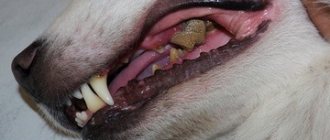It is often said that the condition of the oral cavity indicates the state of health. While this has been proven to be a true fact for humans, let this article alert you that it is true for dogs as well. Bleeding gums in dogs can signal something more serious going on deep inside your beloved family member, ranging from mild oral inflammation and plaque buildup on teeth to various stages and types of oral cancer, and it can be indicative of many systemic conditions. health that can occur undetected and untreated.
Bleeding gums are a condition in which the gums, which appear swollen and red, bleed easily. This condition, in both dogs and humans, usually indicates uncontrolled inflammation and possible infection in the mouth.
Causes of bleeding gums in dogs
- Traumatic or trauma-related gum bleeding can be caused by chewing bones, toys, sticks,
- Penetration of a foreign body that causes bleeding gums - this may be the result of the deep curiosity inherent in dogs,
- Ingestion of toxic foods and substances is food for people that is not recommended for dogs (chocolate, anything containing xylitol, avocado, alcohol, onions, garlic, caffeinated drinks, some fruits, nuts) and toxic substances (antifreeze, various cleaning products), medications),
- Inflammation and further infection due to poor oral hygiene – Your dog’s teeth also need to be brushed regularly; bacteria and plaque can form in a dog's mouth,
- Inflammation caused by systemic diseases - There are a number of systemic diseases in which chronic inflammation is a symptom or contributing factor to gum bleeding (inflammation of the mouth, parasitic, bacterial or fungal infections in other parts of the body, or various types of cancer that can be anywhere in the body ).
© shutterstock
Possible causes of mouth bleeding in dogs
There are many reasons that can cause bleeding in the dog’s mouth and blood. Let's consider the most likely factors.
Injury
A dog can damage the integrity of blood vessels when injured. The owner does not always notice that the dog has hit itself or jumped unsuccessfully. In the event of a strong collision with hard objects in the animal's abdominal cavity, a large vessel may burst, which will lead to bleeding.
Symptoms of injury are very ambiguous and depend on the intensity and location of the injury. If the dog is young and healthy, and the pain from the injury is not severe, it may not show it for some time. With serious injuries, the dog becomes lethargic, begins to whine in pain, refuses food, and takes unnatural poses. Severe blows and ruptures of large vessels lead to death in the absence of urgent help.
An animal with such symptoms should be hospitalized immediately. The clinic will conduct an urgent examination to identify the source of bleeding. Experts will choose the best way to stop it. The dog may need surgery.
Coagulopathy
This pathology is associated with blood clotting disorders.
There are many reasons for the development - from a lack of vitamins to genetic diseases. If a dog is bleeding from its mouth and there are bruises under the skin and on the mucous membranes, most likely the cause is coagulopathy. The blood in such cases is liquid, scarlet, without clots. However, there may be no other significant symptoms. If the pathology develops for a long time, the animal loses weight, does not show high activity, and sleeps a lot. It is necessary to find out what exactly provokes blood clotting disorders and eliminate the cause. In some cases, vitamin therapy and a change in diet help. If the cause is a blood disease, the veterinarian will select the appropriate treatment.
Parvovirus
A very dangerous and persistent virus that affects animals with weak immune systems. Puppies and older dogs are most susceptible to it. Parvovirus can be present in food, in the soil, feces of infected animals, in dirty water, in a word - anywhere. It is transmitted to contacts and remains in the incubation period for a long time.
The most common form of parvovirus is the intestinal form. The infection penetrates the gastrointestinal tract and begins to destroy the mucous membranes. The disease is accompanied by dehydration and abnormal blood composition. Symptoms:
Brief fainting.- Pain (the dog whines, rushes from place to place, clearly shows discomfort).
- Paleness of the mucous membranes.
- Bradycardia (slow heart rate).
- Decreased body temperature.
- Poor appetite, lethargy.
At an advanced stage, blood clots are observed from the mouth of dogs. Blood is often present in urine and stool.
If immediate action is taken and the dog is hospitalized, a successful cure is possible.
Gum diseases
It is not always easy to determine where exactly the blood is coming from - from the mucous membranes of the mouth or from the abdominal cavity, stomach, or respiratory tract. Gingivitis (inflammation of the gums) causes bleeding, but not too much. Blood is usually secreted with saliva and worsens during and after eating. Gingivitis is caused by viral and bacterial infections, as well as a deficiency of certain vitamins. Symptoms of gingivitis:
- Swelling, redness of the gums.
- Ulcers, rash in the mouth.
- Bad smell from mouth.
- Copious secretion of saliva.
Due to pain during meals, the dog begins to eat poorly, refuses toys, whines, and looks lethargic.
Gastrointestinal diseases
Stomach ulcers, cholecystitis, acute ulcerative colitis are accompanied by bleeding during exacerbation. Gastrointestinal diseases can be caused by infections, but most often they are a consequence of poor nutrition and age-related changes. Old dogs often experience depletion of the stomach mucous membranes, which causes bleeding ulcers. First, blood impurities are observed in the stool. Then bloody vomiting appears. When a dog bleeds from the mouth with clots, this is a harbinger of imminent death in older dogs. A young dog with diseases of the digestive system can be cured.
Symptoms
Symptoms of bleeding gums in dogs are likely to begin quite subtly, which may go unnoticed as you go about your daily life activities with a family (both human and canine) and overwhelming responsibilities. Here are some symptoms of bleeding gums to watch for :
- Halitosis (bad breath) - This may be the most noticeable and early symptom you notice.
- Swollen gums are red or very pink,
- Yellow or brown teeth
- Changes in appetite
- Weight loss,
- Difficulty chewing bones.
Diagnostics
Diagnosing bleeding gums in dogs can be as simple as checking them visually or involving things like X-rays, CT scans, MRIs and surgical biopsies. Here are a few steps that may be involved:
- Your veterinarian will require a complete history of your pet's dietary regimen, any oral hygiene products, health and vaccination history, and any bleeding symptoms you have already noticed, including severity, frequency, and duration.
- He will perform a physical examination and will likely order a series of blood tests to determine normal blood components, the possibility of infection (bacterial or fungal), and evaluate certain vitamin and mineral components for proper balance.
- He may take various tissue samples and also perform a stool and urine test.
- Based on the results of his examination, your history, and the results of the blood test, he may need to have a radiographic examination (X-ray), CT scan, or MRI study to determine any potential masses or other abnormalities identified during his examination.
These additional tests will most likely be needed if your veterinarian suspects that there is an underlying systemic cause for the inflammation being noted in the mouth. His treatment plan will depend on the results of this testing and will focus on the underlying cause, whether periodontal disease or other systemic problems.
© shutterstock
Treatment
Treatment for bleeding gums in dogs will depend on the cause. If the cause is determined to be purely oral, then your veterinarian will recommend appropriate veterinary dental care from a veterinarian who is trained to do so.
- The dental care that is needed can range from that needed to treat mild gingivitis (the earliest and mildest form of gum disease) to that needed for more intensive treatment of periodontal disease (the more severe stage of gum disease).
- If the cause is found to be systemic, the treatment plan may include different medical interventions for different medical problems in which inflammation is a factor.
- These medical interventions can range from dietary changes to promote or improve nutrition, digestion and absorption of food to the administration of medications for systemic disease (thyroid dysfunction, diabetes, Cushing's syndrome) to complete surgical removal of the malignant tumor followed by radiographic postoperative treatment.
Of course, it goes without saying that the prognosis for your pet's bleeding gums depends on the cause of the bleeding gums. Many dogs suffer from undiagnosed and untreated gum disease at various stages of development. And, as in humans, inflammation, which causes gum disease and bleeding gums in dogs, can also cause a variety of systemic diseases, some of which are serious and life-threatening for the owner, whether human or canine.
The most common cause of bleeding gums in dogs is periodontal disease. If you are not already engaged in some degree of oral hygiene routine, it would be wise to consult your veterinarian for recommendations and training on what you should do, how you should do it, and the frequency with which it should be done. made.
Clinical picture
It all depends on the intensity and speed with which blood leaves the lumen of the blood vessels. With massive and rapid blood loss, when the pathology has developed against the background of severe injuries to the uterus, the animal quickly (weakens before our eyes), and at the same speed all visible mucous membranes turn pale. Possible collapse, convulsions, quickly turning into a state. In some cases, death occurs within two to three minutes after the start of bleeding, regardless of what is done (of course, with the exception of emergency surgery in a well-equipped clinic).
With a more moderate course of the underlying disease (with the slow development of a tumor, for example), blood loss increases gradually, gradually. The dog becomes more lethargic, begins to play less, and visible mucous membranes turn pale. The animal loses its appetite and loses weight. Occasionally, dried blood will be visible on the root of the tail and external genitalia.
Important!
There is a common misconception that with uterine bleeding there will definitely be traces and streaks of blood on the external genitalia. So, this is not so - in most cases the cervix will be closed, and blood will begin to accumulate in the cavity of the organ!
So how to stop uterine bleeding, and how realistic is it to do so?
What should you do to stop bleeding in a dog? The owner should always be prepared to deal with injury to their pet. Animals often get them during walks, fights with relatives, or as a result of diseases. Be sure to know the signs of internal bleeding in dogs.
They are very dangerous to health, you need to be able to provide first aid and contact a veterinarian in time. External damage to the skin and nearby tissues provokes the release of blood from various vessels (veins, capillaries, arteries).
In this case, it is immediately clear what to do. In case of internal damage, blood does not come out of the wound, it flows out of one, from natural cavities. How can you tell if an animal needs help?











